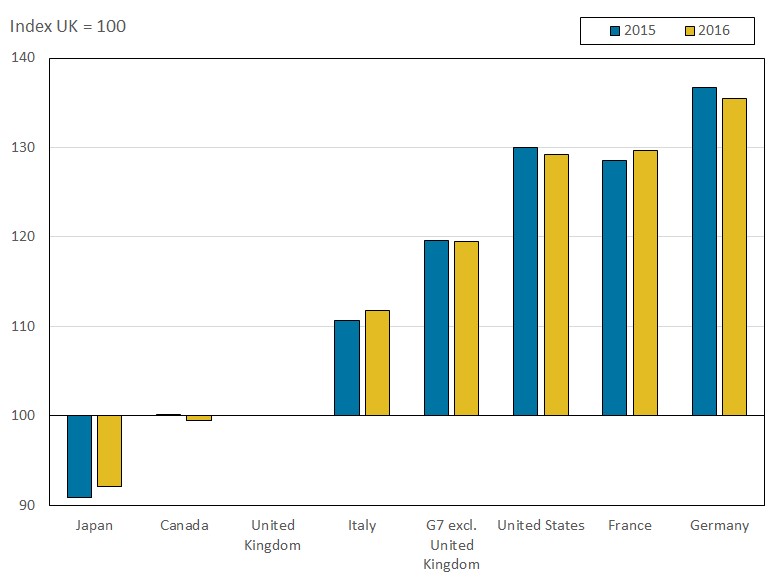Introduction
Productivity is one of the key economic indicators related to economic growth. The US economy is larger compared to the UK and has shown better performance over the last decade. This partially can be attributable to the difference in productivity between the countries. This essay compares industrial and commercial productivity between the UK and the US. The paper finds that the US outperforms the UK in terms of productivity. The gap between the countries is caused by the technological development.
Productivity in the UK and US
According to ONS (2016), UK is behind the rest of the G-7 with a significant productivity gap. The productivity gap slightly narrowed from 16.9% to 16.6%. ONS (2016) measures the productivity as GDP per hour worked. Figure-1 shows comparison between the UK and the rest of G-7 countries.
Figure-1: GDP per hour worked.
Source: ONS (2018)
As can be seen, the UK is about 20% behind the G7 average. The country is significantly behind the US as the gap is about 30%, which means that the US GDP per hour worked is 30% higher compared to the UK.
According to Greasley and Oxley (1998), American leadership in technology development was responsible for the superiority of the US industrial sector compared to the UK. The authors found evidence in favour of segmented convergence between the countries for GDP per capita and real wages. However, the gap in the industrial output per workers is nonstationary and divergent since 1870 (Greasley and Oxley, 1998). The gap in industrial productivity can be linked to the IT sector and the boom in the US during the 1990s. Stiroh (2002) examined the linkage between the technological sector and resurgence in the US productivity in the late 1990s. The results indicate that the IT sector was the key driver of the country’s surge in productivity. However, the rest of the economy that has no relation to the IT did not show substantial improvements in productivity growth (Stiroh, 2002). This surge in the technological sector in the US can be the key cause of the productivity gap between the countries. This relates to the Solow paradox as the UK also experienced a boom in the information technologies that had to result in the productivity growth. According to Basu et al. (2003), there was information and communication technology (ICT) boom in the 1990s in the UK, but its total factor productivity (TFP) declined. Basu et al. (2003) suggest that ICT as a general purpose technology (GPT) can explain this paradox. The lagged investment in ICT in the 1990s in the UK could bring more productivity growth in the future for the UK economy as the US benefited from the spike in ICT investment during the 1980s.
Barnett et al. (2014) suggest that the fall in the UK productivity after the 2008 financial crisis was unusual compared to the previous downturns and the experience of other European countries over the same period. This weakness of the UK productivity can be explained by cyclical variations and the effect of more persistent factors. The strength in hiring cannot explain the slump in the UK productivity while lower investment in capital assets and barriers to efficient capital allocation as well as slower growth in energy and finance contributed to this slowdown in productivity in the UK (Barnett et al., 2014; Goodridge et al., 2018).
Conclusion
The UK economy has lower productivity compared to the rest of the G7 countries and the US, particularly. The start of the productivity gap dates back to the 1990s in the period of investment in ICT and rapid growth of the technology sector. This gap can be explained by a combination of cyclical and persistent factors such as barriers to efficient capital allocation and weak growth in energy and finance sectors.
References
Barnett, A., Battewn, S., Chiu, A., Franklin, J. and Sebastia-Barriel, M. (2014) The UK productivity puzzle, Quarterly Bulletin 2014, pp. 114-128.
Basu, S., Fernald, J. G., Oulton, N. and Srinivasan, S. (2003) The case of the missing productivity growth, or does information technology explain why productivity accelerated in the United States but not in the United Kingdom? NBER Macroeconomics Annual, 18, pp. 9-63.
Goodridge, P., Haskel, J. and Wallis, G. (2018) Accounting for UK productivity puzzle: A decomposition and predictions, Economica, 85(339), pp. 581-605.
Greasley, D. and Oxley, L. (1998) Comparing British and American economic and industrial performance 1860-1992: A time series perspective, Explorations in Economic History, 35(2), pp. 171-195.
ONS (2018) International comparisons of UK productivity (ICP), final estimates: 2016, Office for National Statistics, Available at https://www.ons.gov.uk/economy/economicoutputandproductivity/productivitymeasures/bulletins/internationalcomparisonsofproductivityfinalestimates/2016 [Accessed on 1 June 2021].
Stiroh, K. J. (2002) International technology and the U.S. productivity revival: What do the industry data say? American Economic Review, 92(5), pp. 1559-1576.


